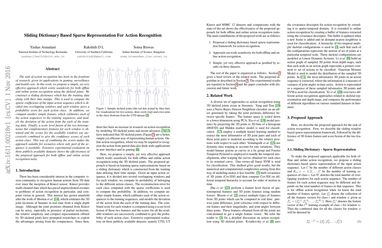Sliding Dictionary Based Sparse Representation For Action Recognition
The task of action recognition has been in the forefront of research, given its applications in gaming, surveillance and health care. In this work, we propose a simple, yet very effective approach which works seamlessly for both offline and online action recognition using the skeletal joints. We construct a sliding dictionary which has the training data along with their time stamps. This is used to compute the sparse coefficients of the input action sequence which is divided into overlapping windows and each window gives a probability score for each action class. In addition, we compute another simple feature, which calibrates each of the action sequences to the training sequences, and models the deviation of the action from the each of the training data. Finally, a score level fusion of the two heterogeneous but complementary features for each window is obtained and the scores for the available windows are successively combined to give the confidence scores of each action class. This way of combining the scores makes the approach suitable for scenarios where only part of the sequence is available. Extensive experimental evaluation on three publicly available datasets shows the effectiveness of the proposed approach for both offline and online action recognition tasks.
PDF Abstract

